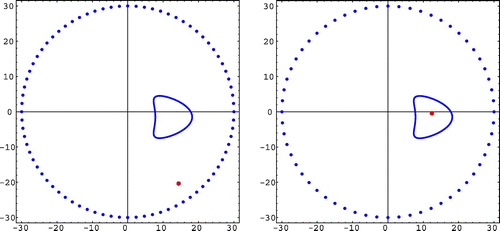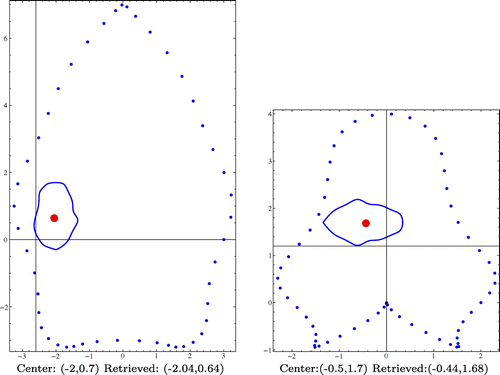 ?Mathematical formulae have been encoded as MathML and are displayed in this HTML version using MathJax in order to improve their display. Uncheck the box to turn MathJax off. This feature requires Javascript. Click on a formula to zoom.
?Mathematical formulae have been encoded as MathML and are displayed in this HTML version using MathJax in order to improve their display. Uncheck the box to turn MathJax off. This feature requires Javascript. Click on a formula to zoom.Abstract
A direct method for the localization of obstacles in a Stokes system is presented and theoretically justified. The method is based on the so-called reciprocity gap functional and is illustrated with several numerical simulations.
1 Introduction
In this work, we consider the following inverse problem: a rigid body (obstacle) occupies a region and is immersed in an incompressible viscous fluid, occupying a bounded domain
. Inside this domain, Stokes system holds. At the boundary, Dirichlet conditions are considered: a prescribed velocity at the accessible part of the boundary,
, and null velocity at the boundary of the obstacle,
. On the other hand, the obstacle produces a stress tensor on
(measured data) from where we want to determine the location of the obstacle. This inverse problem is an example of an inverse obstacle problem in nondestructive testing. Such problems have many applications in several engineering areas (see, for instance, some examples in the book [Citation1]). For the problem here considered we refer the work,[Citation2] where theoretical results concerning obstacle identification from boundary measurements and local stability were established. In [Citation3], an iterative method based on the topological derivative and the Kohn–Vogelius functional is proposed for the identification of multiple 3D small obstacles and their location. In [Citation4], a numerical shape reconstruction method based on integral equations was presented and tested. In this case, the location of the obstacle was assumed to be known. In [Citation5], an optimization method for the reconstruction of both obstacle shape and location was proposed and tested (see also the work [Citation6]). In this case, both shape and location were retrieved simultaneously with an iterative method.
Here, we propose a direct method for the location of a single 2D obstacle based on Green’s formula for the Stokes equations. The method requires the computation of the so-called reciprocity functional at appropriate test functions (see [Citation7] for an application to the determination of point forces in a Stokes system) and can be easily adapted for the 3D case. This type of approach was presented in [Citation8] for the reconstruction of cavities or inclusions in a Laplace problem (see also [Citation9] for the localization of several circular obstacles using the reciprocity gap functional in a transmission problem for the Laplace equation). This work was partially presented by the authors at a conference on the Portuguese Naval School (cf. [Citation10]) and is organized as follows: In Section 2, we define the inverse problem here addressed and the associated direct problem. In Section 3, we present some theoretical results concerning the identification of obstacles from a pair of Cauchy boundary data. Section 4 addresses retrieving of the location using the reciprocity gap functional. We show that the proposed formulae for the location of the obstacle are related to the centre of mass coordinates, for some density functions. Moreover, we show that, for some prescribed boundary velocities, the retrieved centre of mass is related to the centre of the whole domain, . We conclude the paper with a section containing several numerical simulations to illustrate the proposed method.
2 Direct and inverse problems
Let be a simply connected, open and bounded domain with regular
boundary
, which we shall call a regular domain. Let
be a regular domain such that
, meaning that
. Denote by
the boundary of
. Define the domain of propagation
and notice that
. The domain
will represent the region occupied by the fluid whereas
is the region occupied by the obstacle.
Given a boundary velocity of the fluid at
, and the no-slip boundary condition at
, the system of equations governing the fluid flow here considered is given by
1
1 where
is the fluid velocity,
the pressure and
the dynamic viscosity, which we shall assume to be
. Recall that
is the Laplacian and
the gradient of the pressure. The condition
means that
is solenoidal and represents the incompressibility of the fluid. This condition implies that the prescribed boundary velocity
must satisfy the no flux compatibility condition
2
2 where
is the normal field at
, pointing outwards with respect to
. The stress tensor associated to the flux
is
where
is the stress strain tensor of
. In particular, problem (Equation1
1
1 ) can be written as
The direct problem consists in, given a boundary velocity
at
(satisfying the no flux condition (Equation2
2
2 )), determine the generated traction at
,
3
3 where
satisfies Stokes system (Equation1
1
1 ). It is well known that, taking
, where
problem (Equation1
1
1 ) is well posed, with
. The space
is defined as the subspace of
such that
in
. Recall also that the pressure
is unique up to an additive constant and that
where
In this functional setting, we have
.
The inverse problem consists in: given a pair of Cauchy data , where
is defined by (Equation3
3
3 ), determine the location of
. Here, we are assuming only the knowledge of the exterior boundary
and that at the boundary of the obstacle,
, we have a no-slip boundary condition (the geometry of
is, therefore, unknown).
3 Identification and reconstruction results
The following is a well-known identification result of obstacles from a single pair of Cauchy boundary data.
Proposition 3.1
([Citation2, Citation4]) Let be regular domains,
and
,
the corresponding solutions of (Equation1
1
1 ). If
then
Using analytic continuation arguments, the previous identification result is also valid for Cauchy data in an open part of the boundary .
3.1 Reconstruction of circular shaped obstacles
As a consequence of the above result, let us see the following particular case of localization of circular-shaped obstacles. Letand suppose, by simplicity, that
. Define the set of admissible circular-shaped obstacles
Given
consider the vector field
4
4 It can be easily seen that the pair
satisfies Stokes system in the domain of propagation
, considering the boundary velocity
5
5 On the other hand,
6
6 where
Thus, we can define the map
with
defined by (Equation5
5
5 ) and (Equation6
6
6 ), respectively. By Proposition 3.1,
is injective and, in particular, we have the following result.
Lemma 3.2
Let be such that
. Then,
where
is the traction at
generated by the obstacle
and considering the boundary velocity
.
Proof
The map (respectively
) denotes the projection of
onto
(respectively
). Notice that
where
is the traction at
generated by
and considering the velocity
. In particular,
and the triplet
is a solution of the above minimization problem. We now prove that it is unique. Let
be such that
Then,
and the result follows from the injectivity of
.
This lemma shows that the reconstruction of circular-shaped obstacles can be obtained by solving the above minimization problem. However, it requires several boundary measurements which is a drawback when comparing with the iterative method proposed in [Citation5]. Moreover, it relies on an explicit solution of Stokes system for circular-shaped obstacles and it cannot be generalized for other type of obstacles.
4 Recovering the location of an obstacle using the reciprocity functional
Here, we propose a method based on Green’s formula for the location of the obstacle. It requires only one boundary measurement and does not depend on the shape of the obstacle.
Given a regular domain and a regular function
with constant sign, the mass centre of
with density
is the pair
defined by
In particular, when the density is constant, we obtain the so-called centre of gravity
7
7 where
is the area of
. Suppose that
has
boundary. Since for a density function
, there exists an unique
satisfying
then, second Green’s formula (e.g. [Citation11]) yields, for a test function
,
where
is the normal derivative at
. In particular, taking the harmonic test function
we have
Therefore, we can also write the centre of mass
using only boundary integrals,
8
8 In particular, for the centre of gravity, that is assuming
, we get
9
9 where
is given by
and
is the harmonic function in
such that
4.1 Centre of a circle
For the particular case of circular domains , it is well known that (e.g. [Citation12])
10
10 for any harmonic function
in
. Thus, considering the harmonic functions
and
we have, by (Equation10
10
10 ), the following identity for the geometric centre of
,
Notice that this formula coincides with (Equation7
7
7 ). In fact, for
, the function
satisfies
Hence,
4.2 Reciprocity functional for Stokes equations
Let and
, where
and
are any
regular domains. Assuming that the normal at
points outwards with respect to
, we have the following Gauss-Green formula
11
11 Given
, we define the reciprocity functional at
12
12 In the following, we shall assume that
satisfies Stokes system (Equation1
1
1 ). Hence,
13
13 where
is the pair of Cauchy data at
(recall that this data is assumed to be available in the inverse problem). Gauss-Green formula gives
14
14
4.3 Formulae for the centre of mass
Suppose that the pair of test functions satisfy
Then, using (Equation13
13
13 ) we can write the identity
from where we can obtain the following reconstruction method for the centre of mass.
Take and
15
15 where
is the standard basis in
. We have,
On the other hand,
hence, assuming
, we get the approximation
16
16 for the first coordinate. For the second coordinate, we consider
17
17 and obtain
18
18
Remark 1
The above formulae (Equation1515
15 ) and (Equation17
17
17 ) require only a single pair of Cauchy data
on
. On the other hand, no information regarding the shape of
is considered.
The following result shows that in certain cases, the formulae (Equation1515
15 ) and (Equation17
17
17 ) provides the coordinates of the obstacle, for some density functions.
Proposition 4.1
Suppose that . There exists
such that
Moreover,
19
19 where
is the centre of gravity of
.
Proof
We show the above identities for the first coordinate (the second can be obtained in the same manner). Let . Since the bilaplace problem
is well posed in
(e.g. [Citation11]) then, for
Green’s formula yields
for every harmonic test function
. Therefore, taking
we get
Since we also have
then,
Identity (Equation18
18
18 ) follows from the linearity of
since
We now obtain a connection between centre of mass of the obstacle and centre of the whole domain
.
Corollary 4.2
Suppose that the prescribed velocity at
satisfies the orthogonal conditions
20
20 where
and
are the fields defined in (Equation14
14
14 ) and (Equation16
16
16 ), respectively. Then, there exists
such that
and
21
21
Proof
From (Equation1212
12 ), the identities (Equation19
19
19 ) imply
Let
be the extension of
by zero to the whole
. Then,
Remark 2
We can take, for instance, boundary velocities such that
. In fact, since
then
Since
satisfies the no flux condition (Equation2
2
2 ) it follows that
satisfies the hypothesis (Equation19
19
19 ).
Remark 3
Suppose that is a circle. From the above result, if the traction data
, where
and
are constants then the obstacle
should be centred with
, that is,
and
.
5 Numerical examples
5.1 Numerical solution of the direct problem using Stokeslets
In this section, we will make a brief reference to the application of the Method of Fundamental Solutions (MFS) (e.g. [Citation13]) to solve the direct Stokes problem. Such method was used in this work with the aim of generating stress data, , in a finite number of boundary points
.
A fundamental solution for the 2D Stokes system satisfies
where
is the Dirac delta (distribution) centred at the origin. Here, we consider the Stokeslets
where
stands for the tensor product. The MFS for the 2D Stokes flow consists in taking the approximations for the velocity and pressure (see [Citation14]) as
22
22 and
23
23 where
are source points placed at an artificial boundary located outside the physical domain
and
are sources on an interior artificial boundary contained in
. The basis functions
are the canonical components
and
.
The coefficients that will determinate the approximation, can be computed by fitting the Dirichlet boundary conditions at some collocations points, that is,
(
) and
(
).
Here, we considered a least squares fitting which leads to the following system of linear equations,where
is given by 2D blocks,
and
where
and
, with
.
5.2 Location reconstruction
In this section, we will present three examples in order to illustrate the feasibility and stability of the proposed method. The location of the obstacle is retrieved as where the coordinates are given by the formulae (Equation15
15
15 ) and (Equation17
17
17 ). In other words,
If the boundary velocity
satisfies the orthogonal conditions (Equation19
19
19 ) then the previous expressions can be written as
We approximate the above line integrals using a trapezoidal rule. The observation points, that is, the points
where we have the measured data
will be represented by (blue) dots. The shape of the obstacle will be represented by a full blue line and the retrieved location of the obstacle by a bold red dot.
5.2.1 Example 1
We start by studying the influence of boundary velocity . We test two situations: One considering boundary velocity satisfying the orthogonal condition (Equation19
19
19 ) and other not satisfying this condition. The considered obstacle was the kite, defined by the parametrization
Figure 1. Reconstruction results from two boundary velocities satisfying (right plot) and not satisfying (left plot) the orthogonal condition (Equation1919
19 ).
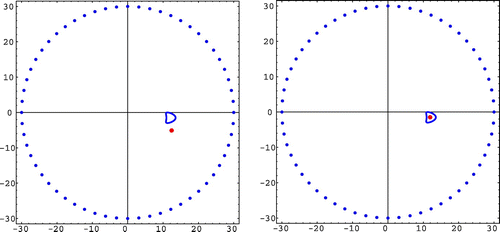
We considered and the boundary velocities
and
. Notice that
and
satisfies the orthogonal condition (Equation19
19
19 ) (see remark 2). We took the measured data at 60 observation points uniformly distributed over
, without adding noise. As we can see in Figure (right plot) we were able to retrieve the location of the obstacle, when the boundary velocity satisfies the orthogonal condition (Equation19
19
19 ). For this case, the retrieved location was
. When we considered the boundary velocity
we obtained the location
, which is a bad result (see the left plot of the mentioned figure). The results deteriorate by increasing the size of the obstacle (see Figure ).
Table 1. Reconstruction of a small circular obstacle immersed in
.
Table 2. The same as the previous Table but considering the domain .
5.2.2 Example 2
In this second example, we tested the sensibility of the method with respect to the size and location of the obstacle. We started by testing the effect of the size on the reconstruction results. We considered the circular obstacle bounded by immersed in two regions: first, a region bounded by
and then bounded by
. The velocity field prescribed at
was
.
The centre was retrieved using 10, 30 and 60 observations on . The numerical results are summarized in Tables and , respectively. Overall, we obtained good reconstruction results even in the presence of noisy data.
Figure 3. Reconstruction results considering 10 boundary observations and several obstacle shape and location.
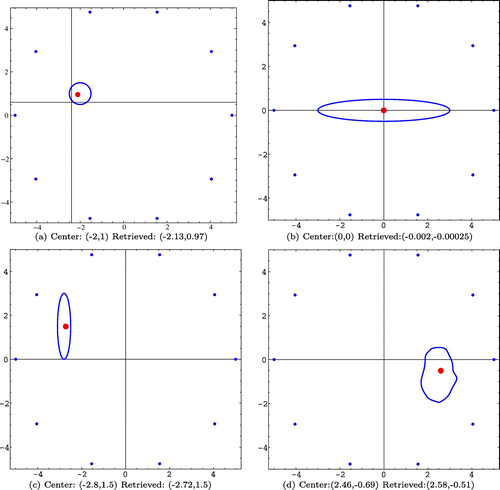
Next, we considered several star-shaped obstacles with different geometries and locations. The boundary velocity was for the first example and
for the others. We took 10 noise-free boundary measurements and obtained the results presented in Figure . Notice that the last obstacle (plot (d) of Figure ) is not symmetric. The parametrization of the corresponding boundary is
5.2.3 Example 3
In this example, we considered two different geometries for the enclosing domain . In both cases, the domains are star shaped and nonconvex (see Figure ). The boundary velocity was
and the noise-free measured data were obtained at 50 observation points. As we can see in Figure , the location of the obstacle was retrieved accurately.
Last simulations concern a nonconvex shark-shaped obstacle. The boundary is given by the parametrization24
24 and the enclosing domain
is the open ball of radius 30 centred at the origin. The velocity considered was
and we obtained the corresponding (noise free) measurement and 10 observation points (see Figure for the reconstruction results). Other location and dimension for the shark was also considered (Figure ). Moreover, we tested for noisy data and obtained good reconstruction results.
Figure 5. Localization of a shark. On the left, a plot of the obstacle, observation points and detected location (red bold dot). On the right, a plot of the obstacle and the retrieved location, .
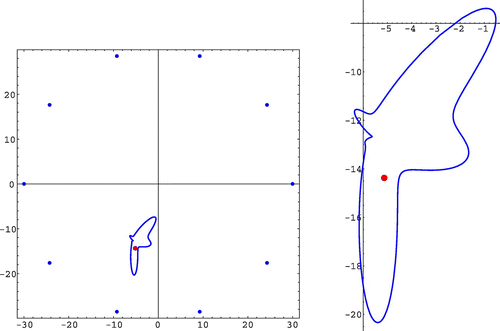
Last simulations are an attempt to recover the centre of the object from partial data. In one case, we took 30 observation points at the first quadrant (left plot of Figure ). A second situation where the observations’ points were located on the first, second and third quadrants is illustrated by right plot of Figure . In both cases, the results were not good and an a priori data completion method is required.
6 Conclusions
In this paper, we proposed a reconstruction method for the location of a single 2D obstacle in a Stokes flow, using the so-called reciprocity gap functional. The method is sufficiently general and can be easily adapted for 3D problems and other type of inverse obstacle problems. It is very fast and the numerical simulations shows that is accurate and stable. The good performance of the method can be exploited in, for instance, inverse geometric problems, where the geometry of the obstacle is also the goal. These problems are usually tackled as an optimization problem for both shape and location (e.g. [Citation5]). However, a more direct approach can be applied when the location of the obstacle is known (e.g. [Citation15]).
As seen in the last couple simulations, it requires data on the whole , which can be a drawback.
References
- Isakov V. Inverse problems for partial differential equations. Vol. 127, Applied mathematical sciences. New York (NY): Springer; 1998.
- Alvarez C, Conca C, Friz L, Kavian O, Ortega JH. Identification of immersed obstacles via boundary measurements. Inverse Probl. 2005;21:1531–1552.
- Caubet F, Dambrine M. Localization of small obstacles in Stokes flow. Inverse Probl. 2012;28:105007.
- Alves CJS, Kress R, Silvestre AL. Integral equations for an inverse boundary value problem for the two-dimensions Stokes equations. J. Inverse Ill posed Probl. 2007;15:461–481.
- Martins NFM, Silvestre AL. An iterative MFS approach for the detection of immersed obstacles. Eng. Anal. Bound. Elem. 2008;32:517–524.
- Karageorghis A, Lesnic D. The pressure-stream function MFS formulation for the detection of an obstacle immersed in a two-dimensional Stokes flow. Adv. Appl. Math. Mech. 2010;2:183–199.
- Alves CJS, Silvestre AL. On the determination of point-forces on a Stokes system. Math. Comput. Simulation. 2004;66:385–397.
- Alves CJS, Martins NFM. Reconstruction of inclusions or cavities in potential problems using the MFS. In: Chen C, Karageorghis A, Smyrlis Y,editors. The method of fundamental solutions – a Meshless method. Atlanta (GA): Dynamic Publishers; 2008. p. 51–71.
- Talbott S, Spring H. Thermal imaging of circular inclusions within a two dimensional region. Terre Haute (IN): Department of Mathematics, Rose-Hulman Institute of Technology; 2005.
- Martins NFM, Soares D . Localização de obstáculos submersos a partir de dados na fronteira [Localization of immersed obstacles from boundary data]. Conf. Jornadas do Mar; Portugal: Escola Naval; 2012. p. 12–16.
- Chen G, Zhou J. Boundary element methods. London: Academic Press; 1992.
- Evans LC. Partial differential equations. Vol. 19, Graduate studies in mathematics. Providence (RI): American Mathematical Society; 1998.
- Bogomolny A. Fundamental solutions method for elliptic boundary value problems. SIAM J. Numer. Anal. 1985;22:644–669.
- Alves CJS, Silvestre AL. Density results using Stokeslets and a method of fundamental solutions for the Stokes equations. Eng. Anal. Bound. Elem. 2004;28:1245–1252.
- Alves CJS, Martins NFM. The direct method of fundamental solutions and the inverse Kirsch-Kress method for the reconstruction of elastic inclusions or cavities. J. Int. Equat. Appl. 2009;21:153–178.

